The events of 15th August 1940.
This date was perhaps Yorkshire's blackest day in the entire War and to create the fuller picture I have created a webpage to try and explain the events of the day and to list known casualties on the ground. I would welcome additions to this page.
At around lunchtime on Thursday, the 15th August 1940 a huge force of Luftwaffe aircraft were detailed to attack airfields in Yorkshire, as they approached the North East coast they were picked up by the British early warning system. They came in two waves, flying in from the north were Heinkel He111's with escorting Me110's from Stavenger detailed to attack Dishforth and Linton on Ouse airfields and instructed to drop their bombs over Newcastle, Sunderland or Middlesbrough should the primary target be unreachable. In many cases these aircraft flew way off course and crossed the North East coast some seventy miles too far north, as a result Dishforth and Linton on Ouse escaped but damage was caused in the secondary targets along the North-East coast. Full details of the damage and losses sustained in this part of the raid are to be found in Bill Norman's book "Broken Eagles 2".
The other phase of the attacking Luftwaffe force involved around fifty Junkers Ju88 aircraft detailed to attack Driffield airfield with the units taking partbeing No.1,2 & 3 Staf.I/KG30 based at Aalborg-West, No.4 Staf.II/KG30 based at Grove but operating this day out of Aalborg-West and No.7,8 & 9 Staf.III/KG30 based at Aalborg-West. The were picked up on the British early warning system as they approached and aircraft from 616 Squadron and 73 Squadron were scrambled to intercept them. The attacking force crossed the Yorkshire coast in the Reighton area of East Yorkshire, between Filey and Bridlington. Having been partly intercepted by aircraft of 616 Squadron and 73 Squadron near Bridlington and were split from one large group. Some of the enemy dropped their bombs over Bridlington and one aircraft headed north and attacked Scarborough.
The main force, now around thirty aircraft, were seen to fly west towards Garton on the Wolds then they turned back towards Driffield airfield to make their attack from the north-west, presumably so they could then fly straight out to sea. They attacked Driffield airfield at around 13.20hrs and the attack lasted for around 45 minutes with them dropping around one hundred bombs on the aerodrome and the surrounding area with further bombs falling near Southburn village. Ten aircraft sustained damage resulting in all of them being written off. There was also damage sustained to four of the five hangers, the living accommodation and other buildings. In total fourteen people lost their lives as a result of this enemy action at Driffield; thirteen were military personnel and one civilian also died. Fourteen military personnel and two civilians were detained in hospital for treatment with five other RAF personnel being slightly injured. Pretty much all of those killed were Yorkshiremen. Fifty years after the incident a memorial was placed at the airfield entrance. Those who lost their lives as a result of Driffield being attacked were..
AC1 John William Morgan Windle RAFVR (752773), aged 36, of Withernsea. Buried Hull Eastern Cemetery, Yorkshire. (77 Sqn).
AC2 Arthur Sydney Daws RAFVR (752795), aged 36, of Hull. Buried Hull Northern Cemetery, Yorkshire. (77 Sqn).
AC2 Eric Offord RAFVR (948296), aged 20, of Crossgates, Leeds. Buried Driffield Cemetery, Yorkshire. (77 Sqn).
ACWm2 Marguerite Hester Hudson WAAF (882414), aged 19, of Wadley, Sheffield. Buried Wisewood Cemetery, Sheffield, Yorkshire. The 1st WAAF to be killed by enemy action in the UK.
LAC Harold Donkin RAF (632880), aged ? Wife of Leeds. Buried Kirkstall Cemetery, Leeds, Yorkshire. (77 Sqn). Died in Hospital.
LAC Kenneth Eric New RAF (567295), aged 21. He married a local girl and is buried in Bridlington Cemetery, Yorkshire (72/W). (77 Sqn).
AC2 Eric Vincent Horton RAFVR (751162), aged 30. Of ? Buried Driffield Cemetery, Yorkshire.
Pte Thomas Round (D/39274), East Yorks Reg, 6th(HD)Bn. Aged ? Of ? Buried Driffield Cemetery, Yorkshire.
Pte Joseph Devereaux (D/27752), East Yorks Reg, 6th(HD)Bn. Aged ? Of ? Buried Driffield Cemetery, Yorkshire.
Pte Clarence Whittleton (D/38889), East Yorks Reg, 6th(HD)Bn. Aged ? Of ? Buried Driffield Cemetery, Yorkshire.
Cpl Frank Rate White (D/26440), East Yorks Reg, 6th(HD)Bn. Aged 40, of Hull. Buried Hull Eastern Cemetery, Yorkshire.
Pte Alfred Harrison (D/37429), East Yorks Reg, 6th(HD)Bn. Aged 45, of Wakefield. Buried Wakefield Cemetery, Yorkshire.
Civilian - Mr Frank Ibbitson, of 11 George Street, Driffield. Died at Driffield. Aged 65. Buried Driffield Cemetery, Yorkshire?
Died of wounds - Transmitter operator - Gunner Geoffrey Ward Turner (1523282) Royal Artillery (295 Bty,96 HAA Regt), aged 24, of Adel, Leeds. Cremated Leeds (Lawns Wood), Yorkshire.
Died of wounds - LAC Bertram Ash RAFVR (944309), aged 22, of Dinnington. Died of injuries. Buried Dinnington Cemetery, Yorkshire. (102 Sqn).
Those injured at Driffield were..
P/O George William Salzgeber (/ Salter) RAF (41315) (77 Sqn), of Canada. Seriously injured.
LAC John Martindale RAF (617752), seriously wounded.
LAC Eric James Miller RAF (567648), dangerously wounded.
LAC John Law Matthews RFA (611277), dangerously wounded.
LAC Harold Donkin RAF (632880), dangerously wounded.
P/O George William Salzgeber RAF (41325), dangerously wounded.
F/O James Ronaldson Herbert Lewis RAF (39997), wounded.
P/O William Craig Timoney RAF (41536), wounded.
LAC Arthur Williams RAF (569281), wounded.
LAC James Lewtas Whittle RAF (540800), wounded.
LAC John Arthur Beattie RAF (569468). wounded.
AC2 Lewis Harris RAF (919160), wounded.
Mr A E Hill, wounded.
Mr H Lewis, wounded.
The names of the others injured are not yet known.
The memorial that was within what was Driffield airfield, since its closure public access may be limited to this memorial. I would welcome further information about this. These two photographs were taken by historian Eric Barton around the year 2000 and I thank his son for giving me access to his photograph collection.
AC2 Offord's and Pte's Round, Whittleton and Devereaux's gravestones in Driffield Cemetery, AC2 Daws' grave in Hull, LAC New in Bridlington and Pte Harrison's in Wakefield Cemetery.
ďA pair of semi-detached houses at Bridlington was totally demolished in a recent air raid. One woman was trapped alive. Alderson tunnelled
under unsafe wreckage and rescued the trapped person without further injury to her. Some days later, two five-storey buildings were totally
demolished and debris penetrated into a cellar in which eleven persons were trapped. Six persons in one cellar, which had completely given
way, were buried under debris. Alderson partly effected entrance to this cellar by tunnelling 13 to 14 feet under the main heap of wreckage
and for three and a half hours he worked unceasingly in an exceedingly cramped condition. Although considerably bruised he succeeded in
releasing all the trapped persons without further injury to themselves. The wreckage was unsafe and further falls were anticipated;
coal gas leaks were of a serious nature and there was danger of flooding from fractured water pipes. Despite these dangers and enemy
aircraft overhead the rescue work was continued. On a third occasion some four-storey buildings were totally demolished. Five persons
were trapped in a cellar. Alderson led the rescue work in excavating a tunnel from the pavement through the foundations to the cellar;
he also personally tunnelled under the wreckage many feet into the cellar and rescued alive two persons (one of whom subsequently died)
from under a massive refrigerator, which was in danger of further collapse as debris was removed. A wall, three storeys high, which
swayed in the gusty wind, was directly over the position where the rescue party were working. This was likely to collapse at any moment.
Alderson worked almost continuously under the wreckage for five hours, during which time further air raid warnings were received
and enemy aircraft heard overhead. By his courage and devotion to duty without the slightest regard for his own safety, he set a
fine example to the members of his Rescue Party, and their team work is worthy of the highest praise."
Ms Norah Riley, aged 68, of 37 St.Cuthbert Road, Bridlington. Killed. This house was later rebuilt.
Ms P. Machon, injured.
The names of others injured, unknown.
Master Ernest Desmond Gates, aged 8, of 18 Quarry Mount, Scarborough. Killed in Parnell's Wood.
Mr Walter Scott, aged 45, injured.
Mr Fred Kenyon, aged 40, injured.
Mr Arthur Heelbeck, aged 27, injured.
Mr John Shipley, aged 39, seriously injured.
Mr George Hopper, aged 29, slightly injured.
Mr George Manson, aged 33, slightly injured.
He later returned to active flying and completed a Tour with 77 Squadron in November 1940. He was later awarded the DFC with 139 Squadron in August 1944 flying Mosquitos. In total he did twenty one operational flights on Whitleys and forty on Mosquitos. He rose to the rank of W/Co and was Commended for Valuable Services in the Air at 33 SFTS in Canada in 1946.
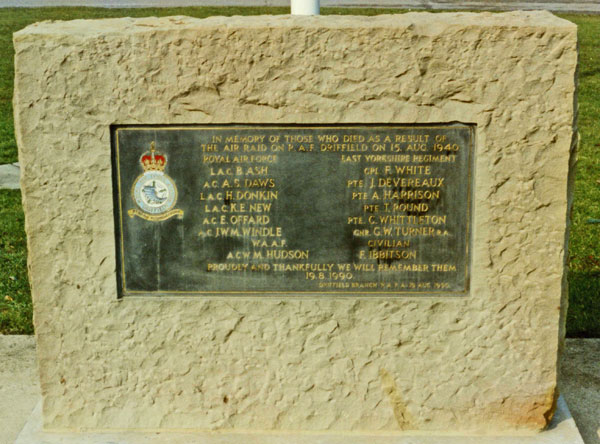
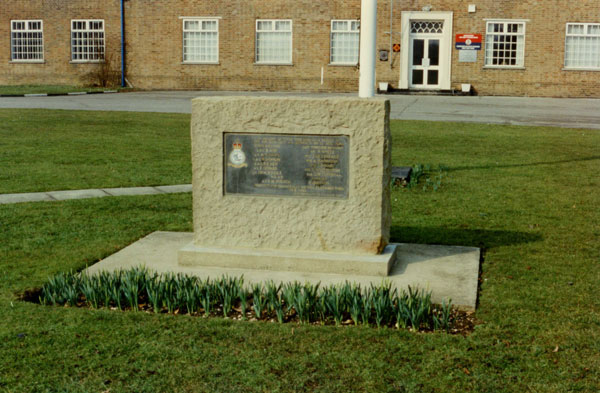
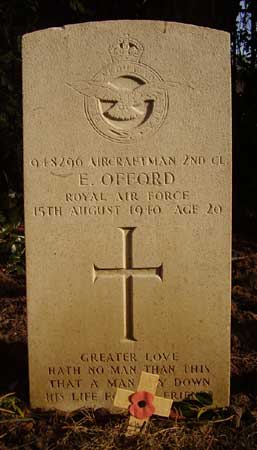

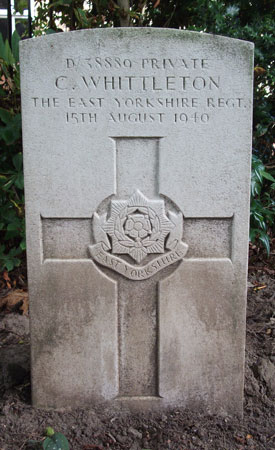

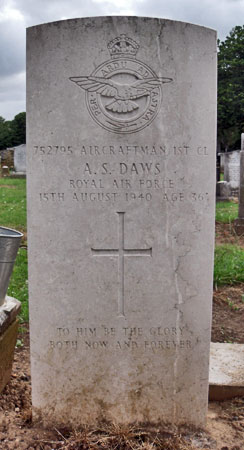
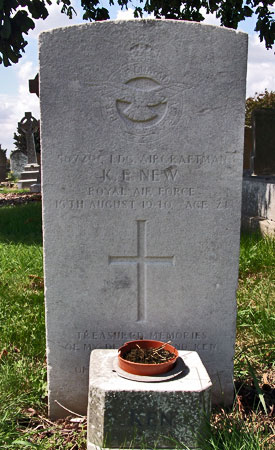
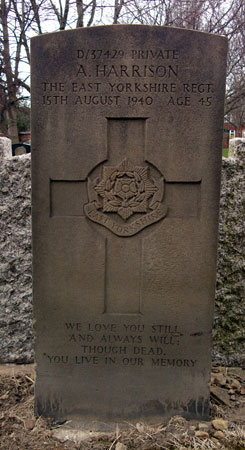
The attack appeared in the newspapers but the location, as would perhaps be expected, was given simply as a "North-Eastern Town". One of the Allied aircraft involved in fighting the enemy bombers off made a force-landing on the airfield later in the day and this incident is covered in its own webpage and at least two other fighters were damaged. The RAF units made claims for many Luftwaffe aircraft being destroyed, probably destroyed or damaged but this number were an exaggeration with many claims being the same aircraft involved. With the confusion of the day this was understandable.
In Bridlington three high explosives exploded in the Byas Avenue/St.Alban Road area and another failed to go off in the St.Alban Road/St.Cuthbert's Road. 16 St.Alban Road was caught in the blast of one bomb and Miss Machon and her family became trapped, they were rescued by the ARP Rescue Party. Bridlington was attacked a number of times in August 1940 and the ARP Rescue Leader Thomas Alderson risked his life a number of times to rescue civilians. For his herioc work in leading this team he was the first recipient of the newly re-instated George Cross, awarded at Buckingham Palace on 20th May 1941. It appeared in the London Gazette on 30th September 1940. The citation reads..
The Scarborough ARP reported a Junkers Ju88 as flying over Scarborough, it then returned at a much lower height and
circled the town once then headed down Seamer Road, after machine gunning trawlers in the bay. It then dived on the gasworks around 13.27hrs
next to the railwayline and machine gunned workers. Four were seriously injured and were treated at hospital, two other workers were
slightly injured. The aircraft then dropped four bombs around the gasworks; three exploded and caught in the blast of one was an eight year old boy
who was playing in nearby Parnell's Wood on the slopes of Oliver's Mount. The Ju88 was seen to be followed out to sea by British fighters and
black smoke was seen to come from an aircraft and it crashed into the sea shortly afterwards. The civilians caught in this attack were..